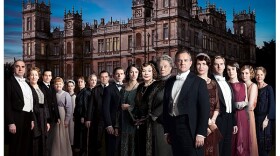
The new movie The Monuments Men depicts the true story of a group of army officers skirting around Europe during WWII trying to save historic works of art. But not many know that there was a similar effort to save works of art in the U.S. And many of the nation's priceless treasures were shipped here to North Carolina.
Here's the improbable story:
In 1941 The National Gallery of Art's first director, David Finley, was a guest of Edith Vanderbilt's at the Biltmore estate in Asheville. A few months later when war clouds were looming and discussions ongoing about how to protect the National Gallery's collection, Finley was trying to think of a remote location to store the art. He needed to find a place that was far from Washington. He wanted to avoid a metropolitan area. Yet he needed a place that was modernized, fireproof. And he thought back to Biltmore.
David Finley called up his friend Edith Vanderbilt and asked if the country were to go to war if he could evacuate some of the country's prized artwork from the National Gallery of Art and bring the items secretly to Biltmore. Mrs. Vanderbilt agreed right away.

The plan for transport was put into place right after the attack on Pearl Harbor. In January of 1942 in the dark of night, in the middle of a snowstorm, a train carrying millions of dollars of artwork departed for Biltmore. The train was met by trucks which secretly whisked the art to the estate. 62 paintings and 17 sculptures were packed up in all.
Darren Poupore, is the chief curator at Biltmore. He says "They were the highlights from 'Art History 101' from your college class. Raphael, Vermeer, Rembrandt, Goya."
The paintings were stored in an unfinished room on the ground floor at Biltmore. The estate retrofitted the room, installing steel vaulted doors and vertical steel shelving from which the paintings could be hung. They also installed draperies over those steel vaulted doors so nothing would look out of place.
The Biltmore house had been open to the public since 1930 and it stayed open. Guests simply walked right by the room where the art was being kept. They had no idea that some of the nation's priceless treasures were a few feet away.
The art stayed hidden at Biltmore for two years.

Those two years, only a few people in the nation were in on the secret. In 1944 when the war ended and the art was returned to Washington, the National Gallery of Art finally told the story of where the art had been stored throughout the duration of the war. "When they entered the District of Columbia they actually had a motorcycle escort ... with great fanfare," says Darren Poupore.
Poupore notes that the project must have been very exciting for the staff at Biltmore: "I just wish I had been the curator at Biltmore about 60 years earlier because I would have loved to see those paintings at Biltmore."












